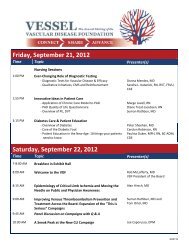V08-N04 - Vascular Disease Foundation
V08-N04 - Vascular Disease Foundation
V08-N04 - Vascular Disease Foundation
You also want an ePaper? Increase the reach of your titles
YUMPU automatically turns print PDFs into web optimized ePapers that Google loves.
Kidney Failure and the Arteriovenous<br />
Fistula Connection<br />
Image of Arteriovenus Fistula connection used<br />
during hemodialysis treatments. Image use<br />
courtesy of the Society for <strong>Vascular</strong> Surgery.<br />
T<br />
he kidneys are an important part of the body; their main job is to<br />
cleanse the blood. When the kidneys fail, an alternative means of regulating<br />
and cleansing the blood becomes necessary. The average person has<br />
two kidneys located toward the back and just above the waist. When working<br />
properly, the kidneys extract waste products from the blood and excess<br />
fluid from thousands of pints of blood each day. The kidneys also balance<br />
chemicals such as phosphorous and calcium in the blood so that our bodies<br />
remain healthy. The blood waste products made up of excess fluid and<br />
chemicals are then filtered out by the kidneys to become urine eventually. In<br />
addition to those functions, the kidneys help regulate blood pressure and<br />
signal the body when to make red blood cells.<br />
If one kidney fails, the other kidney can continue to work and do the job<br />
of both. If both kidneys fail, the blood can no longer be filtered, and waste,<br />
fluid, and chemicals then build up, and become out of balance within the<br />
body. The work of filtering the blood then must be done by a treatment<br />
called hemodialysis, which serves to remove the blood from the body in<br />
order to clean it.<br />
During hemodialysis treatments, blood is removed from the patient's<br />
body through a needle and is run through a tube into a filter that is attached<br />
to a dialysis machine, which balances wastes, fluids, and chemicals. After the<br />
blood is cleansed by dialysis, it is returned to the patient's body through<br />
another tube attached to a second needle.<br />
To remove the blood from the patient's vessels, a surgeon must create an<br />
“access” in the arm that can be used for repeated blood cleansing three times<br />
a week. The access is created by connecting a vein and an artery together,<br />
called an arteriovenous fistula (AVF). The AVF may not be used for dialysis<br />
treatment until six weeks or longer, during which time the vein grows tough<br />
and thick enough to withstand penetration with the dialysis needle.<br />
If a person's blood vessels are too fragile or too small to create an AVF,<br />
the surgeon may create an arteriovenous graft (AVG), which is made from<br />
synthetic tubing used to connect the artery with the vein. Blood flow from the artery goes through the graft and then to<br />
the dialysis machine. Blood is returned to the body through the vein, similar to the AVF. This type of dialysis graft may<br />
be used under certain circumstances within two weeks of surgery.<br />
The dialysis nurse will disinfect the skin prior to inserting the needles into a fistula or graft for the treatments. The<br />
needles are taped in place and are connected to the dialysis machine for the three-to-four-hour treatments. The needles<br />
are removed after each treatment session. Pressure will be held over the site until the bleeding stops. The spot will heal<br />
where the needle entered the fistula or graft. At the next dialysis treatment, the nurse will insert the needle into a different<br />
spot, at least half an inch away from the previous puncture. The dialysis staff will inspect the skin and access for<br />
signs of excessive bleeding, bruising of the tissues, infection, swelling, clotting, or lack of blood flow. These complications<br />
can be warning signs that a doctor's examination may be needed in order to save the dialysis access for future dialysis<br />
treatments.<br />
The access is considered the lifeline for the dialysis patient. If dialysis is needed urgently or immediately, the surgeon<br />
will place a temporary catheter directly into a large vein in the neck to be used for treatments. The catheter has a greater<br />
risk of infection than a permanent access in the arm. Because the temporary catheter is not a long-term solution, an<br />
access in the arm will be placed as soon as possible.<br />
If an AVF/graft is inserted, tight sleeves, watches, or bracelets should never be worn over the graft or fistula. Patients<br />
should never carry purses or shopping bags, sleep on the access, or have blood pressures measured in the arm with the<br />
access. They need to protect the access from any type of activity that could reduce the blood flow through it. The access<br />
should never used for other treatments such as the introduction of intravenous fluids or to take blood samples.<br />
Continued on Page 7<br />
6<br />
<strong>Vascular</strong> <strong>Disease</strong> <strong>Foundation</strong> • www.vdf.org • 888-VDF-4INFO







